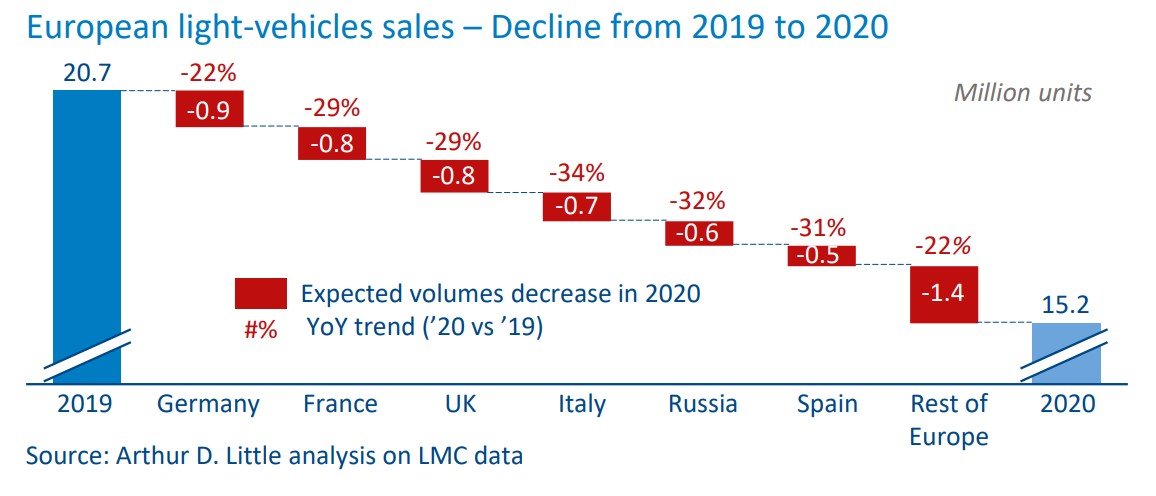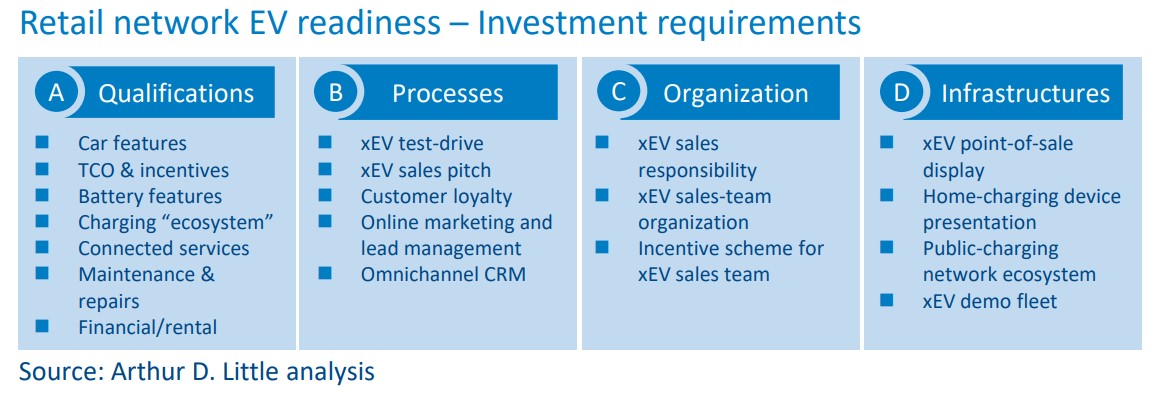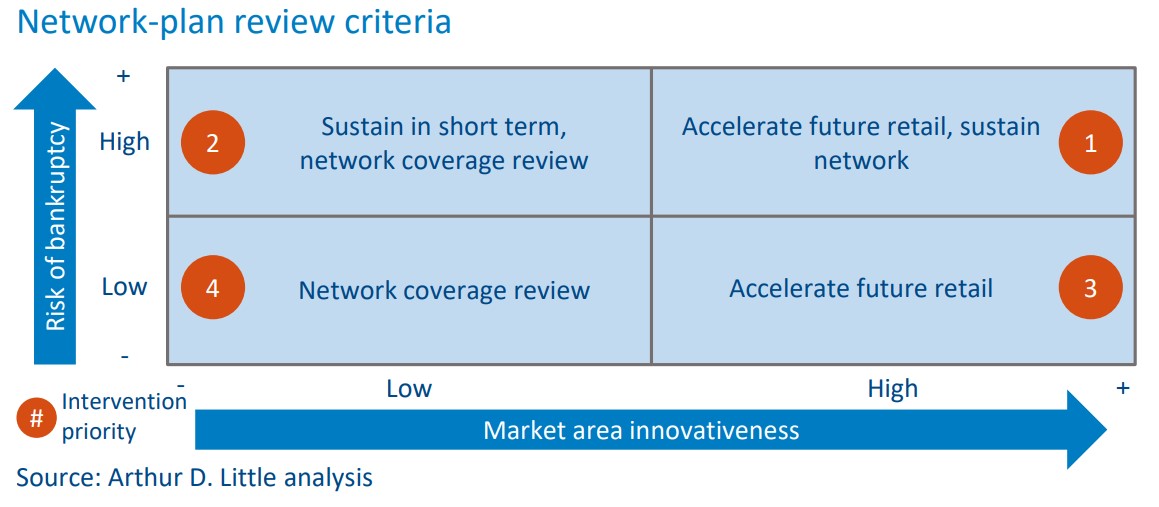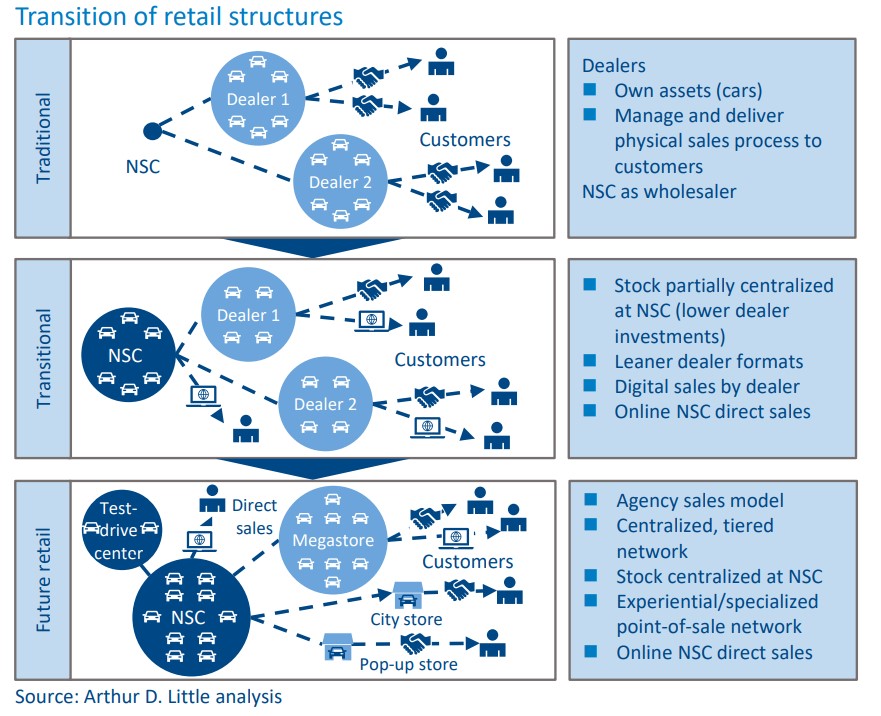
The effects of the COVID-19 crisis on automotive markets highlight the fragility of the traditional car distribution system and intensify the existing need for change. Ongoing transformations such as EV sales, new car ownership models, process digitalization, and new sales models will challenge financially weakened retailers even more. This is the time to accelerate change processes by reviewing and adapting strategies and investment plans, although financial resources will be limited over the next years. OEMs must take this unique chance for bold actions to change the distribution model.
Europe’s new-car business collapsed from February to May 2020, with 20-30% less sales expected for the year
The COVID-19 crisis is causing an unprecedented contraction in car sales across Europe: car sales in 2020 are expected to be down to three-quarters of 2019 volumes.

COVID-19 will negatively affect sales volumes for years – many dealers will fight for financial survival
Lockdowns and sluggish demand in the current recession will seriously affect the entire automotive supply chain, including retailers, for the next two to three years. Our studies and interviews reveal significant financial distress among dealerships: in most impacted markets, about 80 percent of dealers are expected to report losses in 2020, and a percentage are at risk of default. This endangers the survival of 20-40 percent of all dealerships, depending on the market and brand. Due to lower margins, dealers of mass-market brands are more affected than premium-brand outlets. On the high end, luxurybrand dealers are also suffering from high-capital tie-up and low turnover rates.

Purchase incentives for cars or scrappage schemes only help dealers to mitigate the enormous effects of the crisis in the short term. OEMs, national sales companies (NSCs) and importers need to intervene now with changed focus: not only stop traditional retailers from perishing but support and manage the ongoing change processes long term. Measures need to reflect that the effects of COVID-19 have sped up recent trends in car retail.
Trends in the automotive industry brought headwinds to dealerships even before the crisis
Unlike during prior crises, the car industry is amid mutually reinforcing transformations, which all “hit” car retail simultaneously and are now further fuelled by the effects of COVID-19:
- Digitalization of the automotive customer journey:
The way we buy and drive cars and consume mobility is dramatically changing: brick-and-mortar dealerships are losing importance in favor of online channels. - New and more flexible vehicle ownership and usage:
Leasing, rental and subscription of cars and mobility services is becoming more prevalent and attractive – which is affecting dealers’ revenue pools and how they must manage the customer lifetime value and relationship. - Increasing share of EVs and PHEVs:
Demand and supply are shifting towards EV, with an increasing need for investments in dealers’ EV infrastructure, as well as new sales qualifications and processes.
COVID-19 lockdowns and their aftermaths will increase the dynamic of change in automotive retail
The COVID-19 crisis will not bring disruptions to a halt. On the contrary, the crisis is a catalyst and creates opportunities for accelerated change. Understanding and using the opportunities is crucial for the survival of retail networks. As an example, working habits had to adapt to remote work practically overnight. Major beneficiaries of the lockdowns were companies focused on home delivery, online sales and digital communication. This notion is supported by a more detailed view on the major trends.
The transition from “brick-and-mortar” to digitalization of sales will experience a boost
When customers gradually return to the car market after lockdowns, they will use online channels more due to their positive experiences. COVID-19 lockdowns facilitated this when NSCs and retailers focused on remote communication channels or “at-home” services to accommodate social-distancing measures and reduce dependency on in-person dealer visits for customer experience.

Showroom visits from car buyers, which had fallen from four to 1.5 on average before the crisis, could drop even below one. A growing share of buyers are expected to complete their purchases with no in-person dealer visits. For traditional dealers, this could raise the question about their “raison d’être”.
This will be a gradual evolution, and each step will be impacted by the COVID-19 crisis differently:
- Searching for information and configuration of the car: Provide and manage online channels and remote dialogue, e.g., live chats and more customer-centric configurators. Generate customer leads with digital-marketing tools on new channels, including social media formats. COVID-19 effects will further increase the share of online activities in this first step, and vendors that are not present in online channels will quickly become irrelevant to customers.
- Negotiations and contract: Prices are comparable online and via third-party platforms, and individual negotiations for discounts become obsolete. Trade-in evaluation is either conducted online or outsourced to third parties like used-car platforms. COVID-19 will have a strong positive effect on this step, as many customers will overcome long-standing resistance towards actual online purchases and payments through positive experiences in other areas. Increasing demand for online vehicle trade-ins as an integral part of the overall digitalized purchase journey is also expected.
- Test-drive offering: Arranging test-drives needs to be seamlessly integrated into the online-purchase journey. The test-drive itself will also be affected: slightly lower demand is likely in favor of virtual user experiences and remote presentation. Besides that, a growing model line-up and increasing financial limitations among dealers in the crisis could lead to more centrally provided and financed “demo car stocks” at test-drive centers.
- “Delivery at home” or “delivery centers”: Direct delivery to the customer at home or via a delivery center, the factory or an urban flagship store, will gain importance for customers. Delivery centers can be managed by dealers or by the NSC through an agency model. Home delivery could experience a push because of lasting effects of social-distancing measures.
A shift to more flexible ownership models will be accelerated in the COVID-19 crisis
Facing a recession, many car buyers will avoid or postpone purchasing cars, and instead more flexible modes of usage and ownership will become even more attractive. For example, schemes such as monthly payments and flexible cancellation options can quickly adapt to changing requirements and financial possibilities.
On the other hand, the spread of an infectious disease has a negative effect on all kinds of shared mobility services. Experts expect a trend back to individual vehicle use because of the COVID-19 crisis. This sounds positive for car dealerships, but more of these vehicles will be rented, leased or used in subscription models.
Dealerships and sales structures need to adapt in several ways:
- Customers’ purchase decisions are made more frequently, and customer relationship management needs to be more permanent, hence digital, and include all steps of the journey.
- Customer value and vendor profits are no longer defined by occasional vehicle purchases, but instead by customers’ ongoing mobility needs and loyalty.
- The assets, i.e., the financial value of cars and all risks implied, remain with vendors or their financial partners.
- Offering vehicles through a rental or subscription model requires a new set of qualifications, structures and systems compared to the traditional sales model.
EV sales will depend on regulatory intervention in the mid-term – but challenge dealers anyway
The COVID-19 crisis will not change the overall shift to more climate-friendly vehicles in Europe. Still, the speed of change, i.e., EV share development in Europe during the COVID-19 recovery, will depend on the political direction set by the European Commission and national governments. The different severity of COVID-19 impacts on economies and heterogeneous reactions to the crisis could lead to diverging speeds of electrification.
The shift to EVs requires huge investments in dealerships, e.g., for infrastructure and staff qualification. Those investments will be even more challenging for businesses in financial struggles after COVID-19. Market players in the most impacted countries (e.g., Italy and Spain) could feel forced to select between the preservation of their current distribution systems, which are still highly dependent on ICE sales, and further preparations for the EV era; this could put some dealers on the verge of financial collapse.

However, an “either/or” would create even bigger challenges in the long-term, as European CO2 targets are unlikely to be loosened and the pressure for electrification could increase in 2021 and beyond. In major parts of Europe, governments will ask to accelerate investments in electrification and grant financial support only for climate-friendly technology. Recent stimulus programs from the French and German governments point in this direction, while in Italy, incentives also for latest EURO 6 combustion engine vehicles have just been approved.
OEMs and NSCs need to bear investments in EVs and find ways to sustain their retail networks in the crisis. At least in the midterm, answers could include agency sales models for reduced risks at the dealer level, investment support for dealers, and direct sales of EVs with high sales costs.
COVID-19-accelerated trends ask for new structures, formats and technologies in car retail
- More direct sales structures
With digitalization and changes in ownership models, OEMs and their NSCs achieve a direct interface to their customers – on the other hand, dealerships lose their exclusive role as intermediaries. (See our Viewpoint: Future car sales – How to go direct.) Direct sales by OEMs and NSCs could help financially weakened dealerships, as it relieves them of stock financing. This becomes even more relevant with the increasing popularity of new ownership models. Agency models in which dealers sell cars and services on behalf and at the risk of the OEM and receive service fees could be a “bridge” from dealer-entrepreneurs to a direct-sales model. - More specialized physical sales formats
Increasing cost pressure after COVID-19 asks for leaner sales formats than huge “one for all glass palaces”. Restructured and digitalized customer journeys promote more specialized formats. With an increasingly complex model line-up and lower sales volumes, central “test-drive locations” could lower the costs of retail. Temporary formats with lower standards (“pop-ups”, events) that move across markets, managed directly by NSCs, enable scale effects and reduce costs to entertain many similar-looking local points of sale. - Increased relevance of technology and customer data
Technology to enhance the customer experience throughout the purchase and usage journey becomes crucial. This includes product visualization and communication technology, and virtual and augmented reality. More advanced solutions such as simulators for virtual test-drives and 3D live configurators with augmented reality for demo cars could be used in new sales formats, such as temporary experiential stores. Also, the importance of centralized customer data and a direct customer interface will become even more obvious, when sales and ownership models evolve even quicker during and after the COVID-19 crisis.
A possible path towards the future retail model with new challenges for OEMs and NSCs
Driven by changed customer behavior, as well as financial and structural requirements for OEMs, NSCs and dealerships, the evolution of car-retail structures will speed up in and after the COVID-19 recession. This will affect the roles of players in the traditional three-layer system of OEM, NSC and dealers. OEMs need to reassess their retail networks and accelerate some “future retail” transformations.

The NSC role evolves and attracts more responsibilities and tasks in a centralized, direct sales model, which would also reduce end-to-end distribution costs. For the first step, dealers will have to apply more digital tools in client interaction right now. They need to be supported by their wholesalers, which will take a more active sales role in the second step. By then, those new models and formats will more radically change the automotive distribution structure.
In this evolution, OEMs and NSCs face new challenges:
- Working capital: How to finance stock and manage risks?
- Organization and structures: Additional resources to manage stock and direct sales.
- Systems and capabilities: Customer and vehicle data, systems and qualifications, for sales to end customers.

Car retail will be more digital and direct after the “perfect storm” – OEMs need to act now!
While still focused on immediate crisis response, a review of the network with a mid- to long-term perspective is now necessary.This crisis is an opportunity to accelerate the path to future retail, and to define and test new solutions. This requires bold direction setting and immediate action:
- Put retail in full transformation mode: Use the crisisinduced momentum to change sales departments, NSCs and dealers for the era of digital sales and EVs.
- Go online or go out of business: All players along the purchase journey need to offer integrated, state-of-the-art online services now.
- Leverage new profit opportunities: Tap into new revenue pools from (a)ftermarket to (z)ero-hassle car subscriptions to compensate for decreasing revenues from new-car sales.
ADL supports clients to develop new distribution strategies, plan and implement the digital transformation of OEMs and retailers, and analyze new possible business models and revenue streams.


